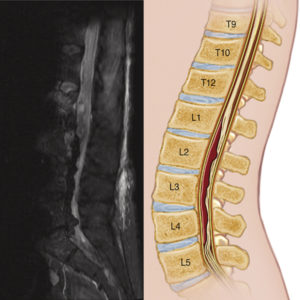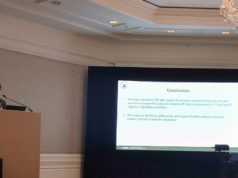
Improvements in techniques of distal organ protection decreased the risk of spinal cord injuries (SCIs) from 30% to <5% with open repair of extent I-II thoracoabdominal aortic aneurysms (TAAAs).1-4 Cerebrospinal fluid (CSF) drainage has been widely accepted as one of the most important prophylactic measures to reduce the risk of SCI during both open and endovascular TAAA repair.5
The evidence for using CSF drainage is from small prospective randomized trials published two decades ago.6, 7 The first study by Crawford and associates in 1991 randomized 98 patients treated by open extent I-II TAAA repair to CSF drainage or no drainage. The maximum volume of drainage was 50ml and was discontinued at the end of the operation. There was no difference in the rate of SCI, which was exceptionally high with (30%) or without (33%) drainage.7 Subsequently, Coselli et al reported a landmark study on 145 patients with extent I-II TAAAs who were randomized to CSF drainage in 76 patients, or no drainage in 69 patients. In that study, drainage was more liberal, averaging 65ml intraoperatively and 260ml postoperatively. The rate of SCI was reduced from 13% without drainage to 2.6% with drainage.6
Since Coselli’s randomized study, CSF drainage has been assumed the gold standard both for open and endovascular TAAA repair. However, this study was never reproduced for endovascular therapy. There is no level I data to support use of CSF drainage for endovascular therapy. Interestingly, Coselli and associates recently reported an updated experience with open repair of 1,114 patients with extent II TAAA. SCI occurred in 15% of all patients, with similar rates with or without drainage. The 15% rate of SCI was nearly identical to the 13% rate observed without drainage.6
The rationale for using CSF drainage is to reduce CSF pressure in order to optimize spinal cord perfusion pressure. Because of the associated edema that follows ischemic injury to the cord, no one argues that CSF drainage is essential to treat SCI. Despite the widespread use of CSF drainage in most reports dealing with fenestrated-branched endovascular aortic repair (FB-EVAR), the rate of SCI has been inconsistent, ranging from 2% to 50%. Paraplegia has been reported in 0% to 29% of patients.5
There are many reasons for the discrepancy in results. First, not all studies have stratified the risk of SCI by aneurysm extent, often mixing lower risk (extent IV TAAA) with higher risk groups (extent I-III TAAA). Second, endpoints are not uniformly defined. Some studies use SCI as any multifactorial lower extremity weakness, while others specify paraparesis and/or paraplegia. Lastly, investigators tend to compare their strategies to prevent SCI, which have been perfected in late experiences, with the outcomes of patients treated without these strategies in their earlier experiences. As such, studies are plagued by learning curve biases.
Therefore, for the most part the recommendations by leading investigators to prevent SCI during FB-EVAR are based on flawed studies We have used a “belt and suspenders” approach to SCI prevention, such as staging of extent I-II TAAAs, routine prophylactic CSF drainage, permissive hypertension, early limb reperfusion, neuromonitoring and selective temporary aneurysm sac perfusion (TAS). Tenorio and associates presented the results of this protocol at the annual meeting of the European Society for Vascular Surgery in 2018.
The study included 232 patients treated by FB-EVAR using a standardized SCI prevention protocol. The risk of any SCI was 1% for pararenal, 0% for extent IV TAAA, 13% for extent III TAAA and 10% for extent I-II TAAA. Permanent paraplegia occurred in 2% of patients with extent I-II TAAAs. There were no cases of permanent paraplegia among extent III and IV TAAAs. A disappointing finding of the study was that two of 10 patients (20%) with SCIs had lesions caused by spinal hematomas caused by CSF drain placement.
This report led us to conduct a taskforce to review the CSF drain practices and outcomes.8 Kärkkäinen and associates reported the results of this review, which included 187 patients and 240 endovascular procedures with CSF drainage. Of these, 21 patients (10%) sustained any CSF drain-related complication.9 The risk of complication was identical to the 10% rate reported by Rong et al in a systematic review of 4,717 patients treated by 6,593 endovascular aortic procedures.10
In our report, severe complications occurred in eight patients (4%), including spinal hematomas in six patients (3%) and intracranial hemorrhage in three (1.5%). There was death caused by intra-cranial hypotension and hemorrhage due to inadvertent drain disconnection. There were a number of other problems, including case cancellations from bloody drainage, drain fracture, CSF leakage, severe headaches and blood patches. Length of stay in the intensive care unit and hospital were prolonged with CSF drainage. One out of three patients (four of 13) with SCI had spinal hematomas.9
Since that report, we changed our practice to avoid any prophylactic drainage during first stage TEVAR and FB-EVAR, including patients with extent I-II TAAAs. Instead, we recommend using therapeutic drainage for patients who develop symptoms of SCI. But is this approach of rescue drainage safe and effective? What is the risk of SCI without drainage? And how often can we actually rescue symptoms?
There is limited data on endovascular repair of extent I-II TAAAs without prophylactic CSF drainage. Bidas and associates reported 142 patients treated for TAAAs, including 88% with extent II or III TAAAs. Prophylactic drainage was used in the first 78 patients, but was discontinued due to a 6% rate of severe complications. After that, 64 patients had repair without prophylactic drainage. Of these, 12 patients (18%) required rescue drainage without drain- related complications. The risk of permanent paraplegia was 2.5% with prophylactic drainage and 1.5% with rescue drainage strategy.11 Adams and colleagues, reported on 270 consecutive patients treated by FB- EVAR. Their 30-day mortality of 0.4% is the lowest ever reported. Patients had no prophylactic CSF drainage and permanent paraplegia occurred in 2% of the entire cohort and 4% of patients with extent I-III TAAAs.3
The rationale for prophylactic drainage relies on the premise that CSF drains help prevent the injury and help decrease the risk of secondary injury by optimizing spinal cord perfusion pressure. It also assumes that placement of CSF drains is safer before the operation starts, and may be potentially dangerous after the operation because of coagulopathy or difficult spinal anatomy, which may increase the risk of complications or even prevent its placement. Nonetheless, there are many cons to be considered. First, evidence shows that CSF drains are probably unnecessary in at least 80–90% of patients who would otherwise never develop SCI symptoms.
These patients are being exposed to unnecessary risks. Second, not all drains actually function. Alqaim and associates reported non-functionality in 16% of patients who received prophylactic drainage.12 Third, SCIs can still occur with CSF drainage and in many cases does not improve at all with functioning drains. Fourth, complications from CSF drains are significant when we consider that the margin for expected complications is low. One in 10 patients have some complication, and one of three with SCIs have spinal hematomas from the drain. Finally, drains are frequently a cause of significant discomfort. There is no question that CSF drains are of paramount importance to treat SCI. No one would argue with that.
But do we need to use them prophylactically? The rationale for an approach that applies only to therapeutic or rescue drainage is based on the premise that CSF drains can still be placed after the operation and can still effectively improve SCI. This premise assumes that placement of CSF drains after the operation is nearly always possible, it is safe and that it improve symptoms. Rescue drainage avoids all the unnecessary drains in those 80–90% of patients who would otherwise have an uncomplicated course. However, this approach has potential limitations. Patients need to have a normal coagulation profile following the operation, for instance. What remains to be answered is how often CSF drains are not able to be placed and how often rescue drainage is not effective. It seems from preliminary data that the number of patients in whom rescue drains are not able to be placed is small, and that most are still effective. The final answer will come from a prospective randomized trial.
REFERENCES
1. Coselli J.S., LeMaire S.A., Preventza O., de la Cruz K.I., Cooley D.A., Price M.D., et al. Outcomes of 3309 thoracoabdominal aortic aneurysm repairs. J Thorac Cardiovasc Surg. 2016;151(5):1323-37.
2. Coselli J.S., Green S.Y., Price M.D., Zhang Q., Preventza O., de la Cruz K.I., et al. Spinal cord deficit after 1114 extent II open thoracoabdominal aortic aneurysm repairs. J Thorac Cardiovasc Surg. 2019.
3. Juszczak M.T., Murray A., Koutsoumpelis A., Vezzosi M., Mascaro J., Claridge M., et al. Elective Fenestrated and Branched Endovascular Thoraco-abdominal Aortic Repair with Supracoeliac Sealing Zones and without Prophylactic Cerebrospinal Fluid Drainage: Early and Medium-term Outcomes. Eur J Vasc Endovasc Surg. 2019;57(5):639-48.
4. Eagleton M.J., Follansbee M., Wolski K., Mastracci T., Kuramochi Y. Fenestrated and branched endovascular aneurysm repair outcomes for type II and III thoracoabdominal aortic aneurysms. Journal of Vascular Surgery. 2016;63(4):930-42.
5. Dijkstra M.L., Vainas T., Zeebregts C.J., Hooft L., van der Laan M.J. Editor’s Choice–Spinal cord ischaemia in endovascular thoracic and thoraco- abdominal aortic repair: review of preventive strategies. European Journal of Vascular and Endovascular Surgery. 2018;55(6):829-41.
6. Coselli J.S., LeMaire S.A., Koksoy C., Schmittling Z.C., Curling P.E. Cerebrospinal fluid drainage reduces paraplegia after thoracoabdominal aortic aneurysm repair: results of a randomized clinical trial. J Vasc Surg. 2002;35(4):631-9.
7. Crawford E.S., Svensson L.G., Hess K.R., Shenaq S.S., Coselli J.S., Safi H.J., et al. A prospective randomized study of cerebrospinal fluid drainage to prevent paraplegia after high-risk surgery on the thoracoabdominal aorta. J Vasc Surg. 1991;13(1):36-45; discussion -6.
8. Tenorio E.R., Oderich G.S., Kärkkäinen J.M., Mendes B.C., Hofer J., Wigham J., et al. Prospective Assessment of a Protocol using Neuromonitoring, Early Limb Reperfusion and Selective Temporary Aneurysm Sac Perfusion to Prevent Spinal Cord Injury During Fenestrated-branched Endovascular Aortic Repair. European Journal of Vascular and Endovascular Surgery. 2019;58(6):e364-e5.
9. Karkkainen J.M., Cirillo-Penn N.C., Sen I., Tenorio E.R., Mauermann W.J., Gilkey G.D., et al. Cerebrospinal fluid drainage complications during first stage and completion fenestrated-branched endovascular aortic repair. J Vasc Surg. 2020;71(4):1109-18.e2.
10. Rong L., Kamel M., Rahouma M., White R., Lichtman A., Pryor K., et al. Cerebrospinal-fluid drain-related complications in patients undergoing open and endovascular repairs of thoracic and thoraco-abdominal aortic pathologies: a systematic review and meta-analysis. British Journal of Anaesthesia. 2018;120(5):904-13.
11. Bisdas T., Panuccio G., Sugimoto M., Torsello G., Austermann M. Risk factors for spinal cord ischemia after endovascular repair of thoracoabdominal aortic aneurysms. J Vasc Surg. 2015;61(6):1408-16.
12. Alqaim M., Cosar E., Crawford A.S., Robichaud D.I., Walz J.M., Schanzer A., et al. Lumbar drain complications in patients undergoing fenestrated or branched endovascular aortic aneurysm repair: Development of an institutional protocol for lumbar drain management. Journal of Vascular Surgery. 2020.
Gustavo S. Oderich, MD, is professor of surgery and chair in the division of vascular and endovascular surgery at the Mayo Clinic in Rochester, Minnesota. Emanuel R. Tenorio, MD, is an advanced endovascular aortic research fellow at the same institution.












